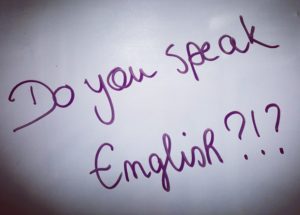Technical manuals: only translate the essentials!
If you take the time to delete any superfluous information, you’d be surprised to discover that a 500 page manual could easily fit in only 250 or 300.
How? Simply by reworking the content, deleting redundancies and restructuring the document in a more intuitive manner. It’s likely that in such documents, a number of the elements wouldn’t even be applicable with your target countries.
You can also take a page from Ikea’s book and replace your text by some cunning drawings! Because, as we all know, a picture is worth a thousand words.
Interestingly, Ikea might have picked up its style from the aeronautics industry, where pictograms have replaced text for decades in on-flight safety guides.
On the subject: have you thought about “testing” the name of the product you plan to export? It can be an interesting experiment; if it turns out that your product name is an insult in Russian, you probably won’t be selling a lot of it there! Our advice: don’t skip any steps. It’s important that your pre-exportation study includes this step.
Interesting fact: we were asked to translate a manual for an electric car whose name meant “pee” in German. Unsurprisingly, we brought this up to the client, but they were too far along to change the name of the vehicle given the amount that had already been committed when we had the discussion. And yet, it’s a good bet that the cars aren’t selling that well on the German market…
Technical manual translations: is it a universal message?
Whatever the content, it’s always a good idea, before launching your project, to ask how pertinent the content in your technical manual is for targeted foreign countries.
Depending on the country, cultural references aren’t the same and what may seem like a benefit isn’t!
How do you navigate such unknown waters? Well, that’s when you should call on a native translator. Only a native professional will be able to inform you of what information about your product may not be useful for your target audience. As always, all work deserves pay, it is generally more expensive than a standard translation.
What is an acceptable price?
The price of a translation can be 10 times greater, depending on the agency you contact! There is a huge gap between delocalized translation platforms and highly qualitative agencies.
Start by estimating how much time it took you to write your technical manual. This will give you an idea of the time that a translator will need simply to draft the manual.
In some instances, translations absolutely require a translator with a style and a sufficient mastery of the undertones in their native language that they can avoid any unwanted mishaps, of which history and legend can name a few.
In any case, stay vigilant. Some translation agencies may offer a “translation for informational purposes only” without specifying or asking after your needs. Beware of markedly less expensive quotes; things that seem too good to be true usually are.
You’re bilingual?

Even if you feel comfortable in a foreign language, writing is a completely different beast than speaking. And believe me, after six years in France, I’m comfortable conversing on nearly any subject, despite my accent, but if you were to ask me to translate something back into French, well, let’s just say you’re better off finding a native! A native speaker will have a more elegant, more fluid writing style.
What’s more, no one will read your technical manuals as carefully as your translator! In fact, quite often our translators will inform us of spelling or grammatical errors in the source document. As a personal aside, I know, only too well, when we see a sentence and we expect to see a word, it’s often easy to gloss over its absence! But, when you’re translating from another language, you tend to be twice as attentive to the source; you want to catch every word to be able to translate the meaning as well as the words. And, what could be better than a second set of eyes from a trained professional?
Note: if you make corrections to your document after receiving the translation from your agency, think about sending the files back for a final validation. The cost of a proofread is worth avoiding any potential misinformation in your documents.
Lessons learned: a truncated phrase, caused by an erroneous copy and paste, led to a magnificent misinterpretation.
Verdict: only looking at the price of a translation is risking the consequences of a poor quality of work.
Choose wisely and, above all, communicate any worries or concerns so that we can better meet your needs!
If you enjoyed our article, please, share it on your social network!



